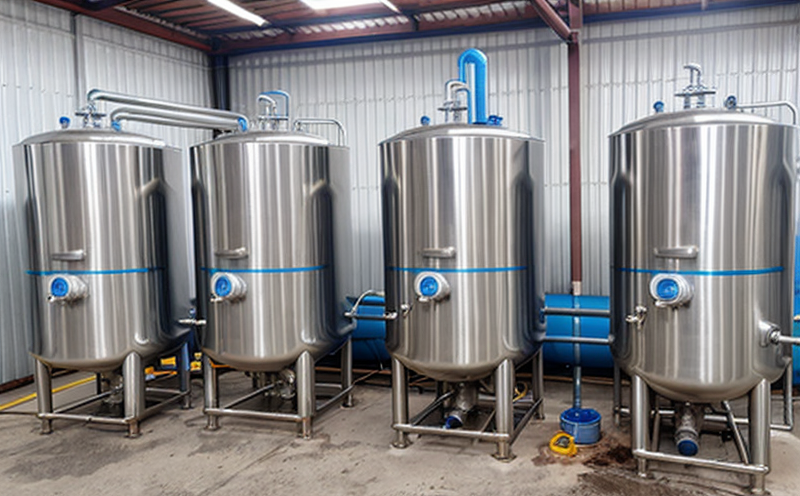ASTM D8025 Microplastics Test in Boiler Water
The ASTM D8025 standard provides a method to detect and quantify microplastics in boiler water. This test is crucial for ensuring the quality of boiler water, which directly impacts the efficiency and longevity of industrial boilers used in various sectors such as power generation, manufacturing, and oil refineries.
Microplastics can enter the system through makeup water sources or as a result of wear and tear within the boiler. If not addressed, these microplastic particles can accumulate to levels that may lead to fouling, scaling, and corrosion, all of which increase operational costs and reduce equipment lifespan. By adhering to ASTM D8025, organizations can maintain optimal water quality and comply with stringent environmental regulations.
The ASTM D8025 method involves several key steps: sampling, filtering the sample, preservation of the filter, and analysis using advanced microscopy techniques such as scanning electron microscopy (SEM) or Raman spectroscopy. The test quantifies microplastics by size and type, providing valuable insights into potential sources and allowing for targeted mitigation strategies.
For accurate results, specimen preparation is critical. Samples must be collected from various points within the boiler system to ensure a representative sample. After collection, the samples are filtered using appropriate pore sizes (typically 1 µm) to capture microplastic particles. The retained material on the filter is then preserved for further analysis.
The ASTM D8025 test focuses on the presence of microplastics in the size range from 1 μm up to approximately 1 mm, which are significant enough to potentially cause issues within the boiler system. By identifying these particles early, facilities can implement preventative maintenance and operational adjustments, thereby avoiding costly downtime and equipment failures.
The results of the ASTM D8025 test provide actionable data that helps quality managers, compliance officers, R&D engineers, and procurement teams make informed decisions about water treatment processes, filtration systems, and chemical additives. This information is essential for maintaining optimal boiler performance and ensuring adherence to international standards like ISO 14001 and OHSAS 18001.
Why It Matters
The presence of microplastics in boiler water can have significant implications for industrial operations. Microplastics, even at low concentrations, can lead to fouling, scaling, and corrosion within the boiler system. Fouling can reduce heat transfer efficiency, leading to increased fuel consumption and operational costs. Scaling deposits can block pipes and heat exchangers, further reducing performance and increasing maintenance requirements.
Corrosion caused by microplastics can weaken the structural integrity of boilers over time, potentially leading to catastrophic failures. These issues not only increase operational expenses but also pose safety risks for personnel working in close proximity to these systems. By conducting regular ASTM D8025 tests, facilities can proactively manage these risks and maintain optimal operating conditions.
Moreover, compliance with environmental regulations is essential for industrial operations. Many regions have stringent laws regarding the discharge of microplastics into wastewater and other natural environments. By detecting and managing microplastics in boiler water through ASTM D8025 testing, facilities can ensure they are meeting these regulatory requirements and maintaining a sustainable operational footprint.
The ASTM D8025 test also supports ongoing efforts to minimize environmental impact by identifying potential sources of microplastics within the system. This information can be used to implement more effective water treatment processes and filtration systems, reducing the overall environmental burden associated with industrial operations.
Industry Applications
| Industry | Application |
|---|---|
| Power Generation | Monitoring boiler water quality to prevent fouling and scaling, ensuring optimal heat transfer efficiency. |
| Manufacturing | Identifying sources of microplastics in process water to maintain product quality and equipment integrity. |
| Oil Refineries | Ensuring compliance with environmental regulations regarding the discharge of microplastics into wastewater streams. |
| Chemical Processing | Monitoring boiler water to prevent corrosion and scaling in critical processing equipment. |
| Pharmaceuticals | Maintaining high standards of water purity for sensitive processes requiring minimal contamination. |
| Paper & Pulp Industry | Preventing fouling and scaling that can disrupt paper-making machinery and reduce output efficiency. |
| Agricultural Chemicals | Maintaining water quality in large-scale production facilities to ensure product safety and efficacy. |
The ASTM D8025 test is widely used across these industries due to its ability to provide detailed insights into the presence of microplastics, which can have significant impacts on operational efficiency and environmental compliance. By integrating this testing method into routine maintenance protocols, facilities can proactively manage risks associated with microplastics in boiler water.
International Acceptance and Recognition
The ASTM D8025 standard has gained significant recognition within the international community for its robustness and reliability. This method is widely accepted by regulatory bodies, industry associations, and environmental organizations around the world. Compliance with ASTM D8025 ensures that facilities are meeting global standards for water quality and environmental protection.
Many countries have adopted ASTM D8025 as a reference standard for monitoring microplastics in various types of water systems, including boiler water. This acceptance is driven by the growing concern over the environmental impact of microplastics and the need for consistent, reliable testing methods. Organizations that adhere to ASTM D8025 can demonstrate their commitment to sustainability and environmental responsibility.
The widespread adoption of ASTM D8025 also facilitates international collaboration and standardization in water quality management. By using a universally accepted method, facilities can ensure consistency across different regions and jurisdictions, making it easier for stakeholders to understand and trust the results.





